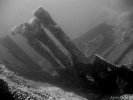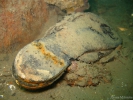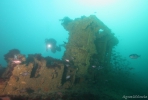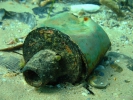|
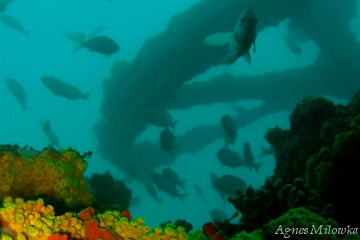
Victoria's wrecks range from those that floundered in wild storms and bad weather to those more or less carefully scuttled, some have been shattered and broken up by the elements and others remain virtually intact. With over 800 shipwrecks recorded in Victoria it is a virtual playground for shipwreck lovers. But it is the SS Coogee that has become my sentimental favorite over the years. It is a truly beautiful wreck parts of which are blanketed by yellow zoathids, adding to its appeal and making it much loved by photographers. It has suffered the typical fate of many a steamship wreck on the bottom of the ocean, the remains of the bow, the stern and the boilers have remained prominent and largely intact while the rest of the ship has collapsed. Before it was scuttled in 1928, the Coogee had an exciting and reasonably long career despite being somewhat accident-prone.
The SS Coogee was a three masted iron screw steamer built in 1887 in England, and was originally known as the Lancashire Witch. It wasn't long before its owner went bankrupt and she made her way to Melbourne and began life as a passenger and cargo steamer on the Melbourne/Launceston and Melbourne/Geelong routes.
She was involved in a number of collisions and other misfortunes. The most famous and destructive of which was the collision with the four masted iron Barque the Fortuna Figaro in the early hours of Christmas Day in 1903. Thick fog meant the two ships didn't see each other till it was too late and the Coogee came away from the collision with a great gash ripped in its bow and a much cleaner deck. The jib boom swept along from one end of the ship to the other ripping away everything in its path - the deck houses, the bridge, lifeboats, ventilators and the funnel… as well as the unfortunate Captain and the man at the wheel who were all killed.
The Coogee however lived to fight another day and by 1910 was refitted and recommenced her Melbourne/Geelong sailing run, until 1914 when she was again involved in a spate of accidents and collisions. First she ran aground on a sandbar, then collided with the Bombala and later the SS Uganda. Perhaps it is unsurprising that with her luck and the hefty repair bills mounting she was eventually withdrawn from the Port Phillip Bay Service.
Towards the end of her life she was used as a minesweeper by the Royal Australian Navy for a few years and then was chartered by the Telegraph Department and used to repair damage to the Bass Strait cable. By 1928 she was deemed too expensive to maintain, was stripped of valuable fittings and scuttled outside the Heads. Which brings us to its current state listing ever so slightly to port and being an absolute treat for divers.
The Coogee is a truly beautiful wreck… it never disappoints. I'm a big fan of this one. She sits in 32m (105ft) of water which is great as it allows for a reasonable bottom time. The three areas of interest are the bow, the boilers and the stern. While you can race around and see the whole length of the wreck in one dive, checking out one end and say the boilers allows you plenty of time to really enjoy it and have a proper poke around. (she was 225 feet or 68.5m in her heyday) There are plenty of nooks and crannies to explore and stick your head into as you head from one end of the wreck to the other and various goodies can be found underneath the collapsed hull such as cuttle fish or even varied catsharks. Fish life abounds on the wreck.
The stern is terribly photogenic with the rudder gear protruding and everything thoroughly blanketed by yellow zoanthids. The steering quadrant is particularly popular with the photographers. There's even a little bit of penetration to be found and you can go under the stern and check out the rudder. There are some nice fans under the stern section to check out and usually a large-toothed beardy.
The boilers are most imposing and you can swim in between them for a bit of fun. Granted, not exactly photogenic… but if nothing else the sheer size is impressive and justifies a look.
The bow is also delightful with some lovely and colorful growth and sponges and nice whips in particular. It's easily recognizable, despite being on its side, as you can still spot the ships railings! There always seems to be a prolific amount of life around this section of the wreck.
So if you are ever in Melbourne and are looking for a good wreck to visit outside Port Phillip Heads, the Coogee should be top of your list. Dive charters visit the wreck on a regular basis, so splash in and enjoy!
|



